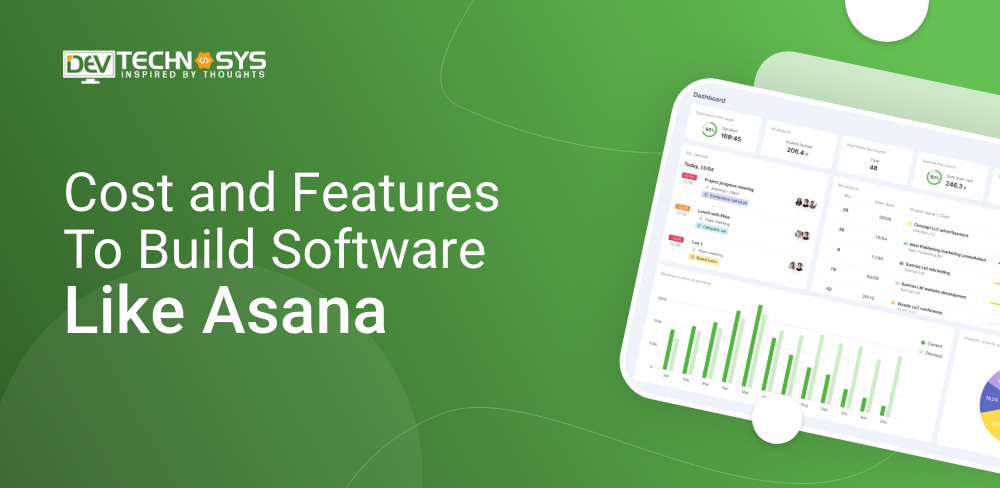Are you looking to build software like Asana? You must read this blog. In today’s fast-paced and collaborative business environment, project management tools like Asana have become indispensable. The ability to streamline workflows, enhance team communication, and increase productivity has made Asana a popular choice. However, have you ever wondered what it takes to build software like Asana?
In this blog post, we will explore the cost and essential features required to build software like Asana. From development expenses to key functionalities, we’ll delve into the crucial aspects to consider, helping you understand the investment required to embark on such a venture.
So let’s begin.
Q1. What is Asana Software?
Asana is a well-known project management tool that aids teams and individuals in planning, monitoring, and managing their work. It provides a collaborative platform for planning, assigning, and monitoring tasks and projects, enabling efficient communication and workflow coordination among team members.
Asana allows users to create projects, set up tasks within those projects, assign responsibilities to team members, and set deadlines and priorities. It offers features such as task lists, calendars, file attachments, comments, and notifications to facilitate collaboration and keep everyone involved up to date with project progress. Additionally, if you want to build software like Asana for your business, then you must hire software developers.
The software offers various views, including a list, board, and timeline, allowing users to visualize their projects and tasks in different formats depending on their preferences and needs. Asana also offers easy data exchange and workflow interaction with other well-liked productivity apps.
Q2. How Does Asana Software Work?
Asana software operates on a web-based platform and follows a simple yet powerful workflow. Users begin by creating projects and defining their objectives. Within each project, tasks are created and assigned to team members. Tasks can include due dates, descriptions, attachments, and tags assigned by users. Asana provides various views, including a list, board, and timeline, which offer different ways to visualize and manage tasks.
Collaboration is a key aspect of Asana, as team members can comment on tasks, mention other users, and have discussions within the context of each task. Notifications keep users informed about updates and changes, ensuring everyone stays on the same page.
Asana also allows for task dependencies, where the completion of one task can trigger the start of another. This feature enables effective project planning and coordination.
Furthermore, Asana integrates with other applications like calendars, file storage platforms, communication tools, and more, enhancing workflow efficiency by connecting various systems and consolidating information.
Asana is the leading work management software platform, with a market share of over 20%.
Q3. Why is Asana Software So Popular?
Asana software has gained popularity for several reasons:
- Intuitive and User-Friendly Interface:
Asana offers a clean and easy-to-use interface, making it accessible to both individuals and teams without requiring extensive training or technical knowledge. Because of its simple design, users can learn how to use the platform fast, which increases user adoption and productivity.
- Robust Task Management Features:
Users may successfully create, assign, prioritize, and monitor tasks with Asana’s robust suite of task management capabilities. Users may effectively organize and manage their work by giving assignments due dates, descriptions, attachments, and tags.
- Collaboration and Communication Tools:
Asana facilitates seamless collaboration among team members. The platform allows for task commenting, mentioning users, and file sharing, enabling real-time discussions and information exchange within the context of tasks. This encourages efficient cooperation and guarantees that everyone remains in sync and informed.
- Flexible Project Visualization:
Asana provides customers with a variety of views, including a list, board, and timeline, allowing them to see their projects in a variety of ways. This adaptability allows for a variety of working methods and preferences, which improves project management and tracking.
- Integration Capabilities:
Asana integrates with a wide range of third-party applications and tools commonly used in the workplace, including communication platforms, file storage services, and calendar applications. This integration capability streamlines workflows eliminates data silos, and increases productivity by connecting various systems.
Q4. How to Use Asana Software?
To use Asana software effectively, follow these steps:
- Sign Up and Create an Account: Create an account on the Asana website (asana.com). Based on your needs, you can select a free or premium plan.
- Create a Workspace: Workspaces in Asana represent your organization or team. Establish a workspace and encourage team members to use it. Create projects: Within your workspace, create projects to organize your work. Projects can represent different initiatives, departments, or specific goals.
- Add Tasks: Within each project, add tasks that need to be completed. Give tasks clear titles and descriptions to provide context. Team members should be given assignments with deadlines.
Asana’s annual recurring revenue (ARR) was $250 million in 2022.
- Customize Tasks: Asana allows you to add more details to tasks. Attach files, add comments, create subtasks, and set task dependencies to streamline your workflow.
- Collaborate and Communicate: Use the commenting feature to discuss tasks, provide updates, or ask questions. Mention team members to bring their attention to specific tasks or discussions.
- Track Progress: Team members can update their progress in Asana as they complete assignments. To monitor the progression and completion of tasks, you can utilize status updates or custom fields.
- Use Different Views: Asana offers different views, such as list, board, and timeline. Experiment with these views to find the one that suits your project management style best.
- Set up Notifications: To get updates on task assignments, comments, and modifications, customize your notification settings. Without filling up your email, this keeps you updated.
- Integrate with Other Tools: Asana integrates with various applications like calendars, communication tools, and file storage platforms. Explore these integrations to streamline your workflow and consolidate information.
Q5. What Are the Top 6 Alternatives of Asana Software?
There are several project management software alternatives to Asana that offer similar functionalities and can be suitable for different needs. Here are six popular alternatives given by a software product development company:
1. Trello
To get updates on task assignments, comments, and modifications, customize your notification settings. Without filling up your email, this keeps you updated. It is known for its simplicity and flexibility, allowing users to create and organize tasks in a highly visual manner. Trello is popular among small teams and individuals who prefer a more lightweight and intuitive project management solution.
2. Jira
IT and software development teams frequently utilize Jira, a powerful project management tool. It offers extensive features for issue tracking, project planning, and agile methodologies. Jira provides a highly customizable and powerful platform, making it suitable for complex projects and larger teams.
3. Monday.com
Monday.com is a versatile team management platform that enables users to plan, track, and collaborate on projects. It offers a visually appealing interface with customizable boards, timelines, and workflow automation. Monday.com is known for its flexibility and wide range of integrations, making it suitable for various industries and project types.
4. Basecamp
Basecamp is a tool for project management and team communications that places an emphasis on usability and simplicity. It provides features like to-do lists, file sharing, messaging, and scheduling, all within a unified interface. Basecamp is often favored by small to medium-sized teams and freelancers who prioritize streamlined collaboration and communication.
5. Microsoft Project
Featuring sophisticated resource management, planning, and scheduling tools, Microsoft Project is a complete project management solution. It provides robust capabilities for tracking progress, managing budgets, and creating Gantt charts. Microsoft Project is commonly used in larger organizations and industries with complex project requirements.
6. Wrike
A project management and collaboration application in the cloud, Wrike provides a wealth of capabilities to speed up business operations. It provides task management, project templates, time tracking, reporting, and collaboration features. Wrike is known for its flexibility and scalability, making it suitable for teams of all sizes and industries.
A Guide To Legacy Software Modernization In All The Industries And Why This Is Important Now?
Q6. What is the Pricing of Asana Software?
In order to meet the needs of various people, teams, and organizations, Asana offers a variety of price options. The cost is determined by the number of users, the number of months, or the number of years. These are Asana’s primary price tiers:
- Free Plan:
For individuals or small teams to get started with project management, Asana offers a free plan with fundamental capabilities. Task lists, limited search, and simple integrations are features available in the free plan.
- Premium Plan:
The Premium plan is designed for teams and offers additional features beyond what is available in the free plan. The pricing of this plan is US$10.99. It includes advanced features such as custom fields, timeline view, advanced search and reporting, and unlimited guest access. The Premium plan is available at a per-user, per-month or per-year subscription.
- Business Plan:
Asana’s Business plan is suitable for growing teams and provides enhanced functionality and collaboration capabilities. The pricing of this plan is US$24.99. It includes features like portfolios, custom rules, forms, proofing, and Salesforce integration. The Business plan is also priced on a per-user, per-month or per-year basis.
Interested in a chatbot demo, pricing, or more info? Fill out the form our expert will contact you shortly.
-
Chatbot Demo
-
Cost to Develop an app
-
Industry Report
-
Case Study
Q7. What Are the Features of Asana Software?
A number of features in the Asana program are intended to aid both individuals and teams in efficiently managing their assignments and projects. You must take assistance from dedicated developers that can integrate salient characteristics in your software:
- Task Management:
Users may create tasks on Asana, assign them to team members, establish due dates, and provide comprehensive descriptions. Projects can organize tasks, and subtasks can be made for more detailed work breakdowns.
- Project Organization:
Users can organize similar tasks into projects by creating them. Projects serve as containers for tasks, enabling better organization and management of work. Projects can be customized with sections, tags, and colors for visual clarity.
- Collaboration and Communication:
By enabling users to comment on tasks, name team members, and hold conversations within the context of particular tasks, Asana promotes cooperation. This fosters effective communication and keeps conversations centralized.
- Task Dependencies:
Asana supports task dependencies, where the completion of one task can trigger the start of another. This function aids in planning and guarantees that activities are carried out properly in order.
- Multiple Views:
Asana offers different views to visualize projects and tasks. The List view displays tasks in a linear format, the Board view presents tasks as columns and cards, and the Timeline view provides a Gantt-like chart to visualize task durations and dependencies.
- Custom Fields and Templates:
Users of Asana can build custom fields to record extra information or particular details pertinent to their projects. Templates can be created to save time and standardize processes for recurring project types.
- File Attachments:
Users can attach files to tasks and projects in Asana, making it convenient to share relevant documents, images, or other resources within the platform. This helps in centralizing project-related information.
- Calendar Integration:
Asana integrates with external calendar applications, enabling users to view their tasks and project deadlines within their preferred calendar tool. This integration helps in managing time and scheduling.
- Notifications and Reminders:
Asana provides customizable notifications and reminders to keep users informed about updates, task assignments, and approaching deadlines. This ensures that team members stay updated on project progress.
Q8. What are the Benefits of Asana Software?
Asana software offers several benefits that can enhance productivity, collaboration, and project management. Here are some key benefits of using Asana:
- Improved Task and Project Organization:
Asana provides a structured framework to organize tasks and projects, enabling users to break down work into manageable units. This promotes clarity, efficiency, and better organization of workflows.
- Enhanced Collaboration and Communication:
By offering a central forum for conversations, task comments, and mentions, Asana enables seamless team communication. It fosters effective communication, reduces email overload, and ensures everyone stays aligned.
- Streamlined Workflow and Task Management:
With Asana, users can create, assign, and track tasks, set due dates, and define dependencies. This streamlines task management and enables team members to understand their responsibilities, prioritize work, and meet deadlines more effectively.
- Increased Visibility and Accountability:
Asana offers transparency into project progress, task assignments, and updates. The ability for team members to quickly assess the progress of tasks and projects encourages responsibility and improves coordination.
Asana’s revenue has grown at an average rate of 50% per year over the past five years.
- Flexibility and Customization:
Asana provides flexibility in organizing projects and tasks according to individual preferences. Users can customize views, create custom fields, and develop project templates to suit their specific needs and work styles.
- Efficient Resource Allocation:
Asana allows users to assign tasks and manage resources effectively. Team members can see their workloads and availability, enabling managers to allocate resources efficiently and avoid overloading individuals.
- Seamless Integration with Other Tools:
Calendars, file storage services and communication tools are just a few of the many third-party programs that Asana interfaces with. This integration enables seamless data sharing, consolidates information, and avoids duplication of efforts.
Q9. What Are the Issues With the Asana Software?
While Asana is a widely used project management software with numerous benefits, there are some potential issues or limitations to be aware of:
- Complexity for Beginners:
Asana’s feature-rich nature may initially overwhelm new users or those unfamiliar with project management software. The learning curve can be steep for individuals without prior experience with similar tools.
- Lack of Advanced Project Planning Features:
Asana focuses primarily on task and project management, but it may lack some advanced project planning features found in dedicated project planning software. For organizations with complicated project requirements, this could be a constraint.
- Dependency on Internet Connection:
Asana is a web-based application, thus a steady internet connection is essential. If users encounter internet outages or poor connectivity, they may have trouble accessing or updating tasks.
- Limited Free Plan Features:
While Asana offers a free plan, it has limitations compared to paid plans. Some advanced features, integrations, and customization options are available only with the paid subscription tiers. Organizations with specific requirements may need to upgrade to access those features.
- Notification Overload:
Asana’s notification system can generate a high volume of notifications, especially for team members involved in multiple projects or tasks. Managing and customizing notifications to avoid information overload can be challenging.
Q10. How Does Asana Software Make Money?
Asana generates revenue through its subscription-based pricing model. The company offers several paid plans with different features and capabilities, providing users with options based on their needs and team size. The paid plans typically offer additional functionalities and advanced features beyond what is available in the free plan.
Asana’s pricing structure includes individual plans for individuals and small teams, as well as business and enterprise plans for larger organizations with more extensive project management requirements. The pricing is based on a per-user, per-month or per-year basis.
Additionally, Asana offers additional services and features that can be added to the subscription plans at an extra cost. These include features like custom fields, data export, advanced integrations, and premium support.
Asana also offers a free plan that allows users to access basic features and experience the platform’s capabilities. For individuals or small teams with less complex project management requirements, the free plan is designed.
Overall, Asana’s revenue is primarily generated through the subscriptions and add-on services it offers to its user base. By providing a range of plans and features, Asana aims to cater to the diverse needs of individuals, teams, and organizations, generating revenue from their use of the platform.
The global task management software market is expected to reach $4.535.5 million by 2026, growing at a CAGR of 13.3% from 2021 to 2026.
Q11. How Much Does it Cost to Build Software like Asana?
Depending on a number of variables, such as the complexity of the features, the size of the development team, the technology stack, and the timetable for development, the cost to build software like Asana can vary dramatically.
Building a project management software with similar functionalities to Asana can be a substantial undertaking, requiring a significant investment of time, resources, and expertise. Here are some cost components to consider:
- Development Team
- Development Time
- Technology Stack
- Design and User Experience
- Features and Functionality
- Testing and Quality Assurance
- Ongoing Maintenance and Support
It is difficult to give a precise cost estimate for developing software like Asana because of all the variables at play. However, it is not uncommon for the development cost of such a project management software to range from $25000-$50000, depending on the scale and complexity of the project.
It is recommended to consult with an experienced software development company or professionals to get a more accurate cost estimate based on your specific requirements and desired features.
























